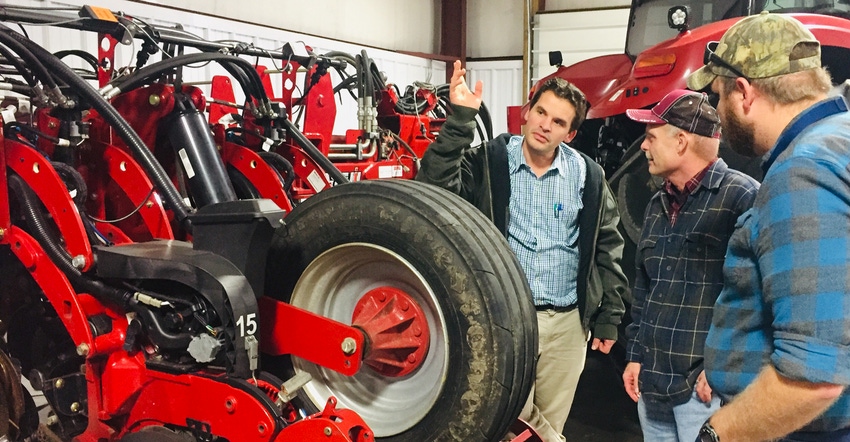March 18, 2020

More than 83,000 farms make up a $10 billion agricultural industry in the Chesapeake Bay watershed.
How can farmers make the best nitrogen management decisions when dealing with weather, nutrient sources and soil variability? The use of digital agriculture software has made achieving these goals easier.
Nitrogen modeling is a quickly expanding and improving tool that is designed to optimize supplemental nitrogen fertilizer applications by calculating a crop’s nitrogen needs based on site-specific inputs. The models then draw in local weather data to quantify microbial mineralization of the soil’s organic nitrogen pools and provide the farmer with real-time estimates of nitrogen availability and nitrogen loss.
From the estimates provided, rate recommendations are determined for any additional nitrogen fertilizer applications that may be needed to optimize fertilizer inputs and maximize yield while reducing the risk of nitrogen runoff.
The Pennsylvania 4R Alliance, in partnership with Granular, recently hosted a field day at Lesher Poultry Farm in Chambersburg, Pa., to showcase the use of 4R precision ag technologies to meet both environmental and economic goals. The PA4R Alliance brings together a diverse group of stakeholders that share the goal of advancing the 4Rs in PA: applying the right nutrient source at the right rate, the right time and in the right place to maximize nutrient use efficiency and minimize nutrient losses.
Leslie Bowman, cropland manager for Lesher Poultry, talked about the steps he takes on the farm to manage his inputs, implement regenerative practices, and comply with federal, state and local conservation requirements. A big part of that is using N modeling software to provide precise management recommendations.
Bowman works with Kent Martin, a Granular certified service agent who works for Crop Production Services in Shippensburg, Pa., on using the Granular program, which is one of several N modeling options on the market. While more options are being developed, other popular programs include Adapt-N and Climate FieldView.
Regardless of the N modeling program being used, Martin and Bowman note that there are several factors that should be considered before jumping in:
Data in, precision out. “The models are only as good as the information put into them,” Martin says. “More accurate and precise data from your fields will result in individualized recommendations on nitrogen needs throughout the growing season and beyond.”
Documented nutrient use of residual nitrogen in the soil and early season inputs will help to hone the model and provide precise recommendations for your crop. Locally calibrated soil characteristics based on surveys from the United States Geological Survey and local ground truthing are necessary to ensure best recommendations.
More efficient nitrogen use. Expect less nitrogen loss throughout the growing season. The model determines yield-maximizing nitrogen recommendations and accurately predicts when nitrogen is needed by the plant, reducing nitrogen losses to the environment, runoff or leaching.
Reduced uncertainty. By creating the N model for the season, you will know what to expect as the growing season progresses. Bowman notes that the program allows him to “anticipate needs rather than react to acute problems.”
Models give a farmer more time to plan and schedule additional inputs for large acreage. These models also adapt to changing weather conditions, so farmers can adjust fertilization rates on-the-fly to increase profitability by using only the nitrogen needed.
While there are several N modeling programs out there, all have similarly required site-specific inputs including manure applications, manure analysis, soil organic matter, preseason soil nitrate levels from the previous crop, variety, maturity range and other factors. Many of the models draw weather data from fine-scale weather stations that include rainfall, temperature and solar radiation, which can all influence nitrogen availability and use.
“In my experience, Granular Agronomy has done a great job of providing the correct input for each of these variables, which provides me a much more accurate calculation for my customers than any other method I have used,” Martin says.
Solutions for N management
Kelly Herbick, district sales manager for Granular, talked about the company’s N modeling product.
“Our grid sample functionality enables our growers and a certified service agent to develop detailed seeding, fertility and nitrogen prescriptions for optimal productivity,” Herbick says. “Incorporating soil type classifications and grower-provided historical data, these distinct decision zones ensure inputs are applied at the right rate, at the right time and in the right place. Mistakes in any of these areas are costly for the farm and can result in nutrient loss.”
Accurate input placements at the subfield level are only one benefit of Granular’s farm management software. The company’s satellite-to-soil imagery tools find potential in-field problems before they cause yield impacts.
“Leveraging high-resolution, high-frequency satellite imagery, Granular Insights identifies only those areas of concern, reducing unnecessary herbicide/pesticide applications and expense,” Herbick says. “Off-site nutrient movement is a key concern. Our digital tools address many of the elements impacting runoff.”
Improving nitrogen-use efficiency is not only good for the environment, but also makes economic sense for the bottom line.
If you’re considering using N modeling on your farm, you’ll likely see the benefits of less residual nitrogen remaining in the field or even lost to leaching, runoff or denitrification. Reducing the amount of nitrogen leaving the field can improve water quality in surrounding waterways that eventually lead to the Chesapeake Bay.
Go online to find more information about 4R nutrient stewardship and related events in the Chesapeake Bay watershed.
Turner is the agricultural program manager for The Nature Conservancy in Pennsylvania.
Rosenbaum is the owner of Rosetree Consulting LLC in Shillington, Pa.
Read more about:
NitrogenYou May Also Like




